THE CORONAVIRUS
WHAT IS IT? HOW DID IT START?
WHAT TO DO NEXT.
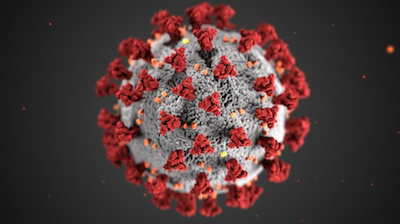
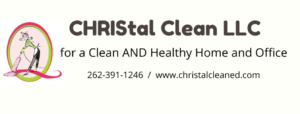
RECENT HIGHLY INFECTIOUS and POTENTIALLY LETHAL DISEASE THREATS
The recent epidemics throughout the world of COVID-19, MERS, SARS, H1N1, H3N2, Norovirus, C. diff, and even Ebola, hemorrhagic fevers, etc. are evidence of just how quickly disease-causing microorganisms can travel and just how much damage they can do. Per the Center for Disease Control (CDC), “…over 30 new diseases have emerged in the last 20 years…”
- Ebola West Africa Outbreak * 2014 (Deadliest of the 5 known strains) * 28,652 Cases / 11,325 fatalities
- Ebola Zaire Outbreaks * 1976, 1984, 1995, 1996, 2000, 2002, 2007 * 50% Average mortality rate (ranging from 25% to 90%)
- H1N1 Spanish Flu Outbreak * 1918 * 50,000,000 – 100,000,000 deaths worldwide * considered the World’s Worst Pandemic * occurred at a time with far less mobility than today
Zoonotic Virus Effect – Cross Species Virus Jumps:
- H3N2 Hong Kong Flu Outbreak * 1968 * over 1,000,000 deaths worldwide / 34,000 in US * avian-pigs-humans
- SARS-CoV-1 (Severe Acute Respiratory Syndrome-COVID) * 2003 * 9-30% mortality rate (50% for those over 60 years old), 8422 cases / 916 deaths * bats–[palm civets, racoon dogs, ferret badgers, domestic cats]-humans
- H5N1 Bird Flu * 2008 * 62% mortality rate (there have been outbreaks in 1959, 1991, 1996, 1997, 2003, 2005, 2007 – ranging from 0% (1959) to 62% (2008), each outbreak becomes deadlier, attacked persons 19-40 hardest * chickens-humans
- H1N1 Swine Flu Pandemic * 2009 * 151,700-575,400 fatalities, 80% of deaths in people younger than 65 years old * pigs-humans
- MERS-CoV (Middle East Respiratory Syndrome – COVID) * 2012 * 1329 cases / 525 deaths / 35% mortality rate / 60-70% if intubated * bats-camels-humans
- COVID-19 / 2019-nCoV / SARS-CoV-2 / Novel Coronavirus (NEW Coronavirus) * 2019-Present * found to be acting differently than SARS and Influenza * 3-4% (estimated) mortality rate * possibly bats-humans
RISK ASSESSMENT AND DEFENSE CONDITIONS
Before we discuss the current issue, we must know that there has been a Risk Assessment Process created by the CDC for the purpose of identifying ‘Sanitary Defense Condition Levels’. This allows for you and your business to assess for ‘Cleaning System Adjustments for Infectious Disease Threats’. The Sanitary Defense Condition Levels are as follows:
SANITARY DEFENSE CONDITION LEVEL 1 – No contagious disease threats. Cleaning evaluated on sight and smell. (Standard Operating Procedures utilized)
SANITARY DEFENSE CONDITION LEVEL 2 – Highly contagious pathogens are in the community. Sanitary cleaning procedures must ramp up.
- Adjustments are made according to the threat level in the products utilized, the procedures followed, and the frequency of the sanitization process.
- Level 2 promotes that ‘Prevention Disinfection of Environmental Surfaces are increased’.
SANITARY DEFENSE CONDITION LEVEL 3 – Highly contagious pathogens are in your home or facility. Implementation of high-level disinfectants and specialty equipment must be utilized to sanitize the building.
Most HOMES & OFFICES in Wisconsin currently find themselves at:
‘SANITARY CONDITION LEVEL 2’
‘Prevention Disinfection of Environmental Surfaces are Increased’
WHAT IS THE CORONAVIRUS?
Coronavirus 2019-nCoV, originally called SARS-COV-2, more commonly referred to in the media as the Coronavirus / COVID-19 and Novel Coronavirus, is a respiratory virus first identified in Wuhan, China suspected to have originated in a large animal and seafood market, known as a ‘wet market’ where animals are chosen alive, killed, and processed in-person. Coronaviruses are a large family of viruses, some of which affect humans while others affect animals only. Severe Acute Respiratory Syndrome (SARS) is a different type of Coronavirus but is NOT the same as what is now being generally labeled “the Coronavirus”.
COVID-19 appears to have a higher contagiousness level as a 1:3 ratio compared to a ‘normal influenza’ which has a 1:1 contagiousness ratio. The ‘Series Interval’ (SI) is extremely high due to the length of incubation period in an infected person allowing the ability to spread much faster and to more persons before presenting symptoms.
However, the chance of becoming infected after exposure is only 10%. Meaning 90% of those exposed will not become infected. This is due to the type of virus it is. There are two types of Viruses: Enveloped and Non-enveloped. Non-enveloped viruses are ancient, have a tough-rigid shell (protein capsid shell), which makes it very difficult to kill (think of a glass or stone marble). An enveloped virus is ‘easy to kill’. It has a Lipid shell which causes vulnerability (picture an egg vs. the marble). COVID-19 is an Enveloped Virus with surface spike Proteins (for it to attach itself inside the lungs) in a lipid shell. Lipid shells are easy to destroy making COVID-19 very vulnerable to proper cleaning and disinfecting techniques, such as washing hands properly.
HOW DOES THE CORONAVIRUS SPREAD?
While we are continuing to learn more about the Novel Coronavirus, COVID-19, scientists believe the virus acts similar to other more well-known Coronaviruses such as MERS or SARS. It is believed that the Coronavirus spreads from person-to-person when in close proximity to each other. The standard accepted distance is about 6 feet. The virus is spread much like the flu by an infected person coughing or sneezing or even talking. This introduces tiny respiratory droplets that can enter a non-infected person’s mouth, nose or be inhaled into the lungs. As with other respiratory viruses, individuals are typically considered to be most contagious when they are demonstrating the greatest level of symptoms.

There are Five major routes of transmission for viruses:
- Contact
- Direct – person to person
- Indirect – through an object (desks, door handles, light switches, counters, tables, chairs, etc.)
- Droplet
- Airborne (non-COVID-19)
- Common Vehicle – phone, purse, shoes, briefcase, pen, shopping carts, etc. (any item anyone can move and touch)
- Vector borne – insect borne (non-COVID-19)
COVID-19 is known to be transmitted via Contact (both direct and indirect), Droplet, and Common Vehicles.
The best known vehicle for transmission is from ‘Surface to Hands to Portals of Entry (Face)’. Viruses can be acquired from environmental surfaces either directly from surface-to-finger-to-mouth or directly from surface-to-mouth. The organisms enter the body through a portal of entry (e.g., mouth, eyes, nose, mucous membranes, etc.)
The surface-to-hands-to-portals of entry is the human’s most difficult action to control. Everyone will, on average, tough a portal of entry at least 20 times per hour!
HOW DOES THE CORONAVIRUS AFFECT SURFACES?
Contaminated droplets settle onto surfaces which people may touch thereby contaminating their hands. If they touch their eyes, mouth or nose before properly disinfecting their hands they may then become infected. Studies have shown the Coronavirus may live on surfaces up to 9 days.
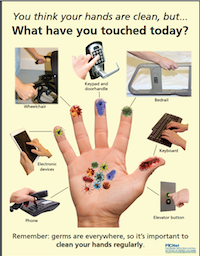
Surfaces act as reservoirs for acquiring the microorganism, which then can either be transferred via the hands to someone else or infect the person who is directly exposed.
WHAT ARE THE SYMPTOMS OF THE CORONAVIRUS?
While the intensity of symptoms varies, with some individuals showing little or no symptoms (asymptomatic) and others demonstrating severe illness and even dying, the three most commonly reported symptoms include:
- Fever
- Dry cough
- Tiredness / Shortness of breath
Other symptoms can include:
- Difficulty breathing (like an elephant sitting on your chest)
- Sputum production
- Runny nose
- Pneumonia
- Diarrhea
The disease in severe cases may ultimately lead to organ failure. Some cases are fatal. Symptoms may appear 2 to 14 days after exposure (there have been some longer incubation cases). Long-term health consequences are unknown at this time.
In New York, there has been a reported 80% mortality rate for those intubated and placed on Ventilators.
Persons over 65 years old appear the most vulnerable, however anyone with a chronic disease is also susceptible. The National Center for Chronic Disease Prevention and Health Promotion (NCCDPHP) says that six in ten Americans live with at least one chronic disease, like heart disease, stroke, cancer, or diabetes.
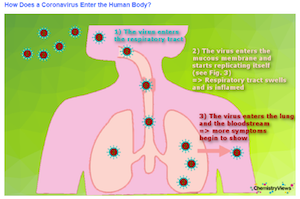
How the Coronavirus Infects a Host:
- The Coronavirus attaches itself to a host cell, enters the cell, and releases content into the host cell (called cytoplasm). Coronavirus then uses the host cell to create new viral contents, replicates itself inside the host cell, and forms new Coronavirus cells which leave the host and then multiply. This continues to infect the entire body leading to organ failure.
HOW CAN I HELP REDUCE THE RISK OF CONTAMINATION?
Knowledge is key to reducing the risk of infection from COVID-19. The information included here is valuable, however developments are made constantly so it is good to monitor official health channels such as the CDC.
- Practicing good infection prevention, such as frequent hand washing, is the most important especially in public buildings or when around others who have been outside your home

- Avoid close contact with people who are sick or are showing symptoms
- Avoid touching your eyes, nose, and mouth with unwashed hands (Avoid Your Holes!)
- Use an alcohol-based hand sanitizer that contains at least 70% alcohol if soap and water are not available
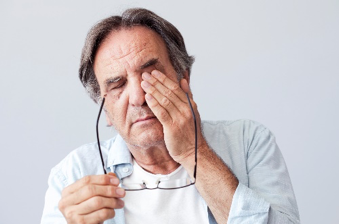
Practices also include; properly cleaning and sanitizing with a disinfectant on all ‘high touch’ surfaces known as ‘Frequently Contacted Surfaces or Objects’ (FCSO).
Home & Business “FCSO” include but are not limited to:
- Door panels and handles/knobs
- Bathroom cabinet and drawer fronts, handles/knobs
- Kitchen cabinet and drawer fronts, handles/knobs
- Kitchen & Laundry appliances and handles/knobs/dials/touchpads (coffee pot, oven, refrigerator, microwave, washer, and dryer)
- Countertops and all small appliances or items
- Kitchen and Bathroom Faucets
- Light switches and plates
- Bedside/couch lamp tables
- Furniture and surfaces
- Lamp switches
- Remote controls
- Thermostats
- Toys
- Stair railings
- Desk tops
- Computers
- Telephone receivers
- Computer mouse and keypads / Alarm keypads
- Copiers and printers
- Tables and chairs
- Soap dispensers
- Lockers
- Showers
- Drinking fountains
- Toilet / bathroom grab bars
- Paper towel dispensers
- Soap Dispensers
- Trashcan lids
- Merchandise racks and display cases/shelves
- Check-out counters and registers
Disinfection of Frequently Contacted Surfaces or Objects (FCSO)
Proactively engage in disinfection activities of FCSOs at your building. The frequency of disinfection and cleaning should be at least daily. In buildings with high population densities or heavy foot traffic, it is advisable to perform disinfection and cleaning of FCSOs more frequently, up to several times per day.
Per the CDC, any product selected for disinfection and cleaning should be registered through the Environmental Protection Agency’s (EPA’s) emerging viral pathogen (EVP) program for use against SARS-CoV-2, indicating its effectiveness for cleaning surfaces with the virus. Alternatively, products that meet the criteria for designation in the EVP program can also be considered for use.
A list of products that are currently registered through the EPA in the EVP program can be found at: https://www.epa.gov/pesticide-registration/list-n-disinfectants-use-against-sars-cov-2 . Some of the products are designated as ready-to-use, are dilutable, or are wipes. Many can be applied through wiping, spraying, misting, or fogging. Any product selected for disinfection and cleaning should be used in strict accordance with the manufacturer’s instructions. Select the product that is most suitable for the FCSO.
Most practices discussed in the media do NOT protect the individual using the practices, but rather protect others in the instance the person is infected. For example, using a mask does prevent airborne droplets from spreading if the individual wearing the mask coughs or sneezes, however the Coronavirus is small enough to enter through the mask to the wearer. Properly cleaning and disinfecting surfaces may be one of the only truly preventative measures available.
WHAT SHOULD I DO IF I BELIEVE I MAY HAVE COVID-19?
Seek medical attention immediately. Call your doctor or local hospital and explain your situation to them. With it being prime season for the Flu and respiratory viruses, it is important to cooperate with medical professionals to reach a proper diagnosis. They may ask you some questions to help such as have you or anyone you have been in contact with recently traveled to China, answer these questions honestly.
How can I avoid spreading it if I am sick?
- Stay home when you are sick or showing symptoms
- Cover your cough or sneeze with a tissue, then put the tissue in the trash so no one else can get to it
- Clean and sanitize frequently touched objects and surfaces
- Read the label on how to use disinfectants and wipes – it will tell you how long the surface needs to be wet to properly kill any germs
WHAT SHOULD I DO IF MY HOME OR OFFICE WAS EXPOSED?
If you believe your home or business may have been exposed to the Coronavirus, it is critical that you take the utmost precaution to avoid contamination or possible infection.
The building should be closed, allowing no one inside until a professional has decontaminated or sanitized the home or facility. The Coronavirus is not something that can be eliminated with standard cleaning products. Hospital-grade disinfectants need to be used in order to effectively treat surfaces and kill the virus. In addition, if proper protective gear is not worn there is a risk of infection to anyone who comes into contact with contaminated surfaces. It is important to contact a trained professional.
HOW CAN I SANITIZE MY HOME OR OFFICE OF CORONAVIRUS?
Properly sanitizing and treating surfaces for Coronavirus is not something an untrained person should ever attempt. The process needs to be completed with extreme precaution and with the proper equipment. CHRIStal Clean has developed several methodologies for sanitization of viruses such as the Coronavirus or influenza virus. We use only EPA/CDC/FDA approved, hospital-grade, non-toxic, all-natural disinfectants to ensure your family, pets, and teams are safe.
COVID-19 OFFICE REOPENING CLEANING/HOME PREVENTATIVE CLEANING
As your business schedules to reopen and return to regular operations, it is important to make sure the necessary precautions are taken. Reentering a facility after COVID-19 requires more than basic cleaning or janitorial services, it requires a company with the experience of handling biohazard cleaning and sanitizing from virus outbreaks.
CHRIStal Clean, utilizing certifications from environmental experts from the Global Biorisk Advisory Council (a division of ISSA) have developed comprehensive cleaning protocols for home and office facilities looking to reopen after the COVID-19 crisis. All of our cleaning and sanitization services use hospital-grade, EPA/CDC/FDA registered products to the exact manufacturer specifications including mixing and dwell time. This is crucial in providing the maximum effectiveness of the disinfecting service.
HEALTH DEPARTMENT COVID-19 GUIDANCE AND REQUIREMENTS
State Health Departments have begun issuing guidance for businesses and facilities preparing to reopen or return to standard business operations. As the guidance becomes available from the state, we will work with the health department, environmental scientists and industrial hygienists to ensure our cleaning and disinfection meets or exceeds all state health department recommendations in addition to the CDC guidelines which we already meet or exceed.
While the CDC does provide guidance for COVID-19 in workplaces, another important source is OSHA which includes regulations for COVID-19 in the workplace under two clauses and standards.
First, under The General Duty Clause, Section 5(a)(1) of the Occupational Safety and Health (OSH) Act of 1970, 29 USC 654(a)(1), which requires employers to furnish to each worker “employment and a place of employment, which are free from recognized hazards that are causing or are likely to cause death or serious physical harm.” Also, under OSHA’s Bloodborne Pathogens standard (29 CFR 1910.1030) which applies to occupational exposure to human blood and other potentially infectious materials. Where respirators are required, employers will also have to comply with OSHA’s Respiratory Protection Standard (29 CFR 1910.134). These standards provide clear requirements of companies to provide safe, healthy environments for their employees.
Some aspects of the guidance state health departments have provided include:
- In addition to maintaining pre-existing cleaning protocols established in the facility, clean and disinfect high-touch areas routinely in accordance with CDC guidelines, in spaces that are accessible to customers, tenants, or other individuals.
- Maintain pre-existing cleaning protocols established in the facility for all other areas of the building.
Our office reopening cleaning includes:
- Hand cleaning of all horizontal and frequently contacted surfaces such as: door handles, keyboards, desks, seating areas, handrails, copiers and printers, shopping carts, production equipment, touch screens and more.
- After hand cleaning all frequently contacted surfaces, CHRIStal Clean will apply an aerosolized (fogging) disinfection solution to frequently touched porous surfaces such as upholstery, carpet, cubicles, etc. We apply an EPA-registered, healthcare-grade disinfectant during this step of the process. All restrooms within the facility will be sanitized from top to bottom including: toilets, sinks, partitions, counters and all other surfaces within the restrooms.
HOME/OFFICE PREVENTATIVE CLEANING SERVICE
The above protocols are also used in our preventative cleaning solutions for both homes and offices to protect family, pets, patrons, clients and customers.
Our preventative cleaning protocols involve not only specific requirements for cleaning and sanitizing, but also the disinfectants and systems to be utilized. We utilize personal protective equipment (PPE) standards for all employees throughout the entire process.
FOGGER vs. PUMP SPRAYER
CHRIStal Clean uses disinfectant foggers in both our preventative cleaning and sanitization services. There are several reasons this is a better application method over standard pump sprayers other companies typically use. First, foggers are faster than standard pump sprayers. A trained technician can disinfect approximately 15,000 square feet using a fogger. On average, this is 10X faster than a standard pump sprayer. Second, the fogging system actually reduces the particles to a much smaller size which helps provide better coverage and more even distribution of the chemical disinfectant. Lastly, since the particle size is smaller, there may be less of an impact on materials which are sensitive to moisture such as paper or fabric.
INDUSTRY TREND: CLEANING FOR HEALTH
Cleaning industry approaches are being taken to ensure homes and offices receive quality services. The industry understands the need to focus on ‘Cleaning for Health’. We at CHRIStal Clean feel we have been ahead of this curve in home cleaning services in Waukesha and have always promoted ‘Clean AND Healthy’ services.
This is to say that we strive to learn more and ensure that we are stopping the cycle of the spreading of infectious elements, requiring new protocols and ‘quality standards’. Requiring effective training and certification of our technicians and adopting an approach that is based on an understanding of the true ‘value of cleaning’ and its impact on health, your family, the environment, and productivity. We are the new ‘FRONT LINE of DEFENSE’ in this fight against the ‘invisible enemy’.
HOW CLEAN IS CLEAN? (FIGHTING THE ‘INVISIBLE ENEMY’)
Surfaces that look clean may not necessarily be clean. Disease causing microorganisms are microscopic, making them invisible to the naked eye. Proper sanitization techniques are the only measure of defense we have when dealing with an ‘invisible enemy’ like COVID-19.
Best Practices for Sanitization Procedures Include:
- Pre-Clean surfaces (Must remove any dirt in which the ‘enemy’ can hide in or under)
- Apply Disinfectant and allow for the proper ‘Dwell Time’ (stay wet)
- Recover wet, spent disinfectant solution (do not allow build up)
- Rinse (again, do not allow build up of your cleaning or disinfectant product)
The proper cleaning and sanitizing technique has an impact on ensuring your surfaces are free of the virus.
“…although thorough cleaning will remove 90% of microorganisms…careless cleaning can have a negative effect, by dispersing the microorganisms over a greater area…” – CDC
A true fact is that a person using the world’s best disinfectant without procedural knowledge will fail at proper disinfection. It is also true that a person with advanced procedural knowledge without the right disinfectant will fail at proper disinfection. It is the marriage of procedural knowledge and disinfectant chemistry that makes it all work.
CONCLUSION
We here at CHRIStal Clean hope the information provided in this ‘white paper’ and planning guide helps you, your family, and your office better prepare for a possible pandemic and the Coronavirus outbreak. We pride ourselves on service excellence and are here to help with any Pandemic Planning you and your organization are completing. We have seen disasters of all types. If you feel your home or office may have been exposed to the Coronavirus or would like help in preparing your Pandemic Plan and Preventative Cleaning Services, we are here to help. To learn more about the Coronavirus, possible exposure and treatment call us at 262-391-1246 or schedule your FREE in-home/office, no obligation estimate at www.christalcleaned.com.
CORONOVIRUS INFORMATION CENTER
In an effort to help contain and prevent the spread of COVID-19 coronavirus, we have developed an information center to help educate families and individuals on the virus. Below are some relevant links to health authorities such as the CDC and World Health Organization. We will be adding to and updating this section on a regular basis.
CDC General COVID-19 Page
https://www.cdc.gov/coronavirus/2019-ncov/index.html
CDC Guidance for home cleaning and disinfecting
https://www.cdc.gov/coronavirus/2019-ncov/community/home/cleaning-disinfection.html
CDC Guidance for businesses
https://www.cdc.gov/coronavirus/2019-ncov/community/guidance-business-response.html
CDC Guidance for disinfecting buildings and facilities
https://www.cdc.gov/coronavirus/2019-ncov/community/disinfecting-building-facility.html
CDC Guidance for schools
https://www.cdc.gov/coronavirus/2019-ncov/community/schools-childcare/index.html
Environmental Protection Agency’s (EPA) Emerging Viral Pathogen (EVP) Program
https://www.epa.gov/pesticide-registration/list-n-disinfectants-use-against-sars-cov-2
World Health Organization Situation Report
Wisconsin Department of Health Services – COVID-19
https://www.dhs.wisconsin.gov/covid-19/index.htm
Wisconsin Department of Health Services – WISCONSIN DATA
https://www.dhs.wisconsin.gov/covid-19/data.htm
Wisconsin Hospital Association